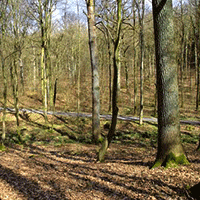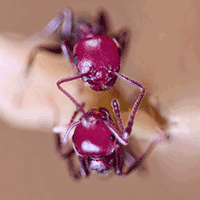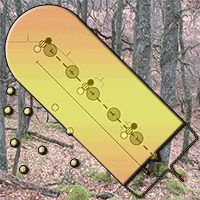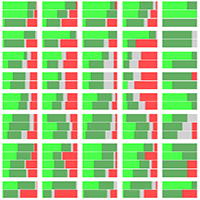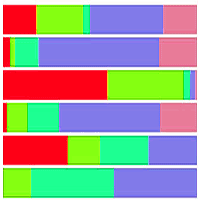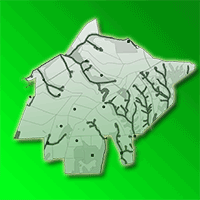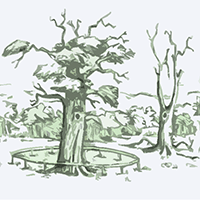We examined the effects of different intensities of forest management on bird communities in the Bialowieza Forest, eastern Poland. Stands that had been managed for more than 100 years (cutting, planting, removal of dead wood) and stands that were partially protected in nature reserves (sporadic sanitary cutting, removal of dead wood until 2008) were compared with unmanaged stands in the Bialowieza National Park by surveying the bird community during three breeding seasons (2010-2012). Surveys were conducted within three forest habitats: spruce-pine (Pino-Quercetum), lime-hornbeam (Tilio-Carpinetum) and ash-alder (Fraxino-Alnetum). Results showed that habitat structure significantly affected the avian community. The basal area of live trees had a positive effect on abundance of birds, while the density of live trees had negative significant effect on bird abundance and species diversity. We also found significantly lower abundance of insectivorous birds and cavity-nesters in managed compared to unmanaged stands. Birds’ assembly in the spruce-pine and ash-alder stands were most sensitive to management. These results show both that management can be used to sustain bird communities, including species of conservation concern, and that inappropriate management may harm them.
Keywords
, , , ,
Citation
Czeszczewik D, Zub K, Stanski T, Sahel M, Kapusta A, Walankiewicz W (2015). Effects of forest management on bird assemblages in the Bialowieza Forest, Poland. iForest 8: 377-385. - doi: 10.3832/ifor1212-007
Academic Editor
Massimo Faccoli
Paper history
Received: Dec 23, 2013
Accepted: Jul 24, 2014
First online: Oct 02, 2014
Publication Date: Jun 01, 2015
Publication Time: 2.33 months
© SISEF - The Italian Society of Silviculture and Forest Ecology 2015
Open Access
This article is distributed under the terms of the Creative Commons Attribution-Non Commercial 4.0 International (https://creativecommons.org/licenses/by-nc/4.0/), which permits unrestricted use, distribution, and reproduction in any medium, provided you give appropriate credit to the original author(s) and the source, provide a link to the Creative Commons license, and indicate if changes were made.

Breakdown by View Type
(Waiting for server response...)
Article Usage
Total Article Views: 55739
(from publication date up to now)
Breakdown by View Type
HTML Page Views: 45325
Abstract Page Views: 4295
PDF Downloads: 4732
Citation/Reference Downloads: 25
XML Downloads: 1362
Web Metrics
Days since publication: 4076
Overall contacts: 55739
Avg. contacts per week: 95.72
Article Citations
Article citations are based on data periodically collected from the Clarivate Web of Science web site
(last update: Mar 2025)
Total number of cites (since 2015): 42
Average cites per year: 3.82
Publication Metrics
by Dimensions ©
Articles citing this article
List of the papers citing this article based on CrossRef Cited-by.
(1)
Bernadzki E, Bolibok L, Brzeziecki B, Zajaczkowski J, Zybura H (1998)Rozwój drzewostanów naturalnych Bialowieskiego Parku Narodowego w okresie 1936 do 1996 [Development of natural forest stands in the BiaÅÂowieża National Park in the period of 1936 to 1996]. Fundacja Rozwój SGGW, Warszawa, Poland, pp. 271. [in Polish]
Gscholar
(2)
Bibby CJ, Burgess ND, Hill DA (1992)Bird census techniques. Academic Press, London, UK, pp. 257.
Gscholar
(3)
Bobiec A (2002)Living stands and dead wood in the Bialowieza forest: suggestions for restoration management. Forest Ecology and Management 165: 125-140.
CrossRef |
Gscholar
(4)
Cholewa M, Wesolowski T (2011)Nestling food of European hole-nesting passerines: do we know enough to test the adaptive hypotheses on breeding seasons? Acta Ornithologica 46: 105-116.
CrossRef |
Gscholar
(5)
Czeszczewik D, Walankiewicz W (2006)Logging affects the white-backed woodpecker Dendrocopos leucotos distribution in the Bialowieza Forest. Annales Zoologici Fennici 43: 221-227.
Online |
Gscholar
(6)
Czeszczewik D, Walankiewicz W, Mitrus C, Tumiel T, Stanski T, Sahel M, Bednarczyk G (2013)Importance of dead wood resources for woodpeckers in coniferous stands of the Bialowieza Forest. Bird Conservation International 23: 414-425.
CrossRef |
Gscholar
(7)
Dawson DG, Bull PC (1975)Counting birds in New Zealand forests. Notornis 22: 101-109.
Gscholar
(8)
DeByle NV, Winokur RP (1985)Aspen: ecology and management in the western United States. Gen. Tech. Report RMRS-GTR-119, Rocky Mountain Research Station, USDA Forest Service, Fort Collins, CO, USA, pp. 283.
Online |
Gscholar
(9)
Diaz I, Armesto JJ, Reid S, Sieving KE, Willson MF (2005)Linking forest structure and composition: avian diversity in successional forests of Chiloe Island, Chile. Biological Conservation 123: 91-101.
CrossRef |
Gscholar
(10)
Durães R, Carrasco L, Smith TB, Karubian J (2013)Effects of forest disturbance and habitat loss on avian communities in a Neotropical biodiversity hotspot. Biological Conservation 166: 203-211.
CrossRef |
Gscholar
(11)
Edworthy AB, Martin K (2013)Persistence of tree cavities used by cavity-nesting vertebrates declines in harvested forests. Journal of Wildlife Management 77: 770-776.
CrossRef |
Gscholar
(12)
Ellison AM, Bank MS, Clinton BD, Colburn EA, Elliot K, Ford CR, Foster DR, Kloeppel BD, Knoepp JD, Lovett GM, Mohan J, Orwig DA, Rodenhouse NL, Sobczak WV, Stinson KA, Stone JK, Swan CM, Thompson J, Von Holle B, Webster JR (2005)Loss of foundation species: consequences for the structure and dynamics of forested ecosystems. Frontiers in Ecology and the Environment 3: 479-486.
CrossRef |
Gscholar
(13)
Fuller RJ (1995)Bird life of woodland and forest. Cambridge University Press, Cambridge, UK, pp. 244.
Gscholar
(14)
Fuller RJ (2000)Influence of treefall gaps on distributions of breeding birds within interior old-growth stands in Bialowieza forest, Poland. Condor 102: 267-274.
CrossRef |
Gscholar
(15)
Ghadiri Khanaposhtani M, Kaboli M, Karami M, Etemad V, Baniasadi S (2013)Effects of logged and unlogged forest patches on avifaunal diversity. Environmental Management 51: 750-758.
CrossRef |
Gscholar
(16)
Gregory RD, Van Strien A (2010)Wild bird indicators: using composite population trends of birds as measures of environmental health. Ornithological Science 9: 3-22.
CrossRef |
Gscholar
(17)
Hauer G, Cumming S, Schmiegelow F, Adamowicz W, Weber M, Jagodzinski R (2010)Tradeoffs between forestry resource and conservation values under alternate policy regimes: a spatial analysis of the western Canadian boreal plains. Ecological Modelling 221: 2590-2603.
CrossRef |
Gscholar
(18)
Hill D, Roberts P (1990)Densities and biomass of invertebrates in stands of rotationally managed coppice woodland. Biological Conservation 51: 167-837.
CrossRef |
Gscholar
(19)
Hutto RL, Pletschet SM, Hendricks P (1986)A fixed-radius point count method for nonbreeding and breeding season use. The Auk 103: 593-602.
Online |
Gscholar
(20)
Keller JK, Richmond ME, Smith CR (2003)An explanation of patterns of breeding bird species richness and density following clearcutting in northeastern USA forests. Forest Ecology and Management 174: 541-564.
CrossRef |
Gscholar
(21)
Kikuchi K, Akasaka T, Yamaura Y, Nakamura F (2013)Abundance and use of cavity trees at the tree- and stand-levels in natural and plantation forests in Hokkaido. Japan Journal of Forest Research 18: 389-397.
CrossRef |
Gscholar
(22)
Kowalski M (1982)Rozwój drzewostanów naturalnych na powierzchni badawczej w Bialowieskim Parku Narodowym [Development of natural forest stands on an experimental area in the Bialowieza National Park.]. Rozprawy naukowe i monografie, Wydawnictwo SGGW, Warszawa, Poland, pp. 87. [in Polish]
Gscholar
(23)
Larsen S, Sorace A, Mancini L (2010)Riparian bird communities as indicators of human impacts along Mediterranean streams. Environmental Management 45: 261-273.
CrossRef |
Gscholar
(24)
Loehle C, Van Deusen P, Wigley TB, Mitchell MS, Rutzmoser SH, Aggett J, Beebe JA, Smith ML (2006)A test of sustainable forestry guidelines using bird habitat models and the Habplan harvest scheduler. Forest Ecology and Management 232: 56-67.
CrossRef |
Gscholar
(25)
Nilsson SG, Niklasson M, Hedin J, Aronsson G, Gutowski JM, Linder P, Ljungberg H, Mikusinski G, Ranius T (2002)Densities of large living and dead trees in old-growth temperate and boreal forests. Forest Ecology and Management 161: 189-204.
CrossRef |
Gscholar
(26)
Piotrowska M, Wesolowski T (1989)The breeding ecology and behaviour of the Chiffchaff
Phylloscopus collybita in primaeval and managed stands of Bialowieza Forest (Poland). Acta Ornithologica 25: 25-76.
Gscholar
(27)
Piratelli A, Sousa SD, Corrêa JS, Andrade VA, Ribeiro RY, Avelar LH, Oliveira EF (2008)Searching for bioindicators of forest fragmentation: passerine birds in the Atlantic forest of southeastern Brazil. Brazilian Journal of Biology 68: 259-268.
CrossRef |
Gscholar
(28)
Przybyl K (2002)Fungi associated with necrotic apical parts of
Fraxinus excelsior shoots. Forest Pathology 32: 387-394.
CrossRef |
Gscholar
(29)
R Development Core Team (2010)R: a language and environment for statistical computing. R Foundation for Statistical Computing. Vienna, Austria.
Online |
Gscholar
(30)
Roberge JM, Angelstam P (2006)Indicator species among resident forest birds - a cross-regional evaluation in northern Europe. Biological Conservation 130: 134-147.
CrossRef |
Gscholar
(31)
Roberge JM, Angelstam P, Villard M-A (2008)Specialised woodpeckers and naturalness in hemiboreal forests - deriving quantitative targets for conservation planning. Biological Conservation 141: 997-1012.
CrossRef |
Gscholar
(32)
Rosenvald R, Lõhmus A, Kraut A, Remm L (2011)Bird communities in hemiboreal old-growth forests: the roles of food supply, stand structure, and site type. Forest Ecology and Management 262: 1541-1550.
CrossRef |
Gscholar
(33)
Rowinski P (2001)Timing of breeding of Nuthatch
Sitta europaea in relation to food resources in a natural forest. PhD thesis, SGGW, Warsaw, Poland, pp. 92. [in Polish]
Gscholar
(34)
Schlossberg S, King DI (2009)Postlogging succession and habitat usage of shrubland birds. Journal of Wildlife Management 73: 226-231.
CrossRef |
Gscholar
(35)
Schowalter TD (1990)Invertebrate diversity in old-growth versus regenerating forest canopies. Northwest Environmental Journal 6: 403-404.
Gscholar
(36)
Schwenk WS, Donovan TM, Keeton WS, Nunery JS (2012)Carbon storage, timber production, and biodiversity: comparing ecosystem services with multi-criteria decision analysis. Ecological Applications 22: 1612-1627.
CrossRef |
Gscholar
(37)
Shannon CE, Weaver W (1949)The mathematical theory of communication. University of Illinois Press, Urbana, IL, USA, pp. 117.
Gscholar
(38)
Spitzer L, Konvicka M, Benes J, Tropek R, Tuf IH, Tufova J (2008)Does closure of traditionally managed open woodlands threaten epigeic invertebrates? Effects of coppicing and high deer densities. Biological Conservation 141: 827-837.
CrossRef |
Gscholar
(39)
Thompson ID, Hogan HA, Montevecchi WA (1999)Avian communities of mature balsam fir forests in Newfoundland: age-dependence and implications for timber harvesting. Condor 101: 311-323.
CrossRef |
Gscholar
(40)
Tomialojć L, Wesolowski T (1990)Bird communities of the primeval temperate forest of Bialowieza, Poland. In: “Biogeography and ecology of forest bird communities” (Keast A ed). SPB Academic Publ. Bv, The Hague, The Netherlands, pp. 141-165.
Gscholar
(41)
Tomialojć L, Wesolowski T (1994)Die Stabilität der Vogelmeinschaft in einem Urwald der gemässigten Zone: Ergebnisse einer 15 jährigen Studie aus dem Nationalpark von Bialowieza (Polen) [The stability of bird community in a temperate primaeval forest: 15-year data from the BiaÅÂowieża National Park (Poland)]. Ornithologische Beobachter 91: 73-110. [in German]
Gscholar
(42)
Tomialojć L, Wesolowski T (1996)Structure of a primaeval forest bird community during 1970s and 1990s (Bialowieza National Park, Poland). Acta Ornithologica 31: 133-154.
Gscholar
(43)
Tomialojć L, Wesolowski T, Walankiewicz W (1984)Breeding bird community of a primaeval temperate forest (Bialowieza National Park, Poland). Acta Ornithologica 20: 241-310.
Gscholar
(44)
Toyoshima Y, Yamaura Y, Mitsuda Y, Yabuhara Y, Nakamura F (2013)Reconciling wood production with bird conservation: a regional analysis using bird distribution models and forestry scenarios in Tokachi district, northern Japan. Forest Ecology and Management 307: 54-62.
CrossRef |
Gscholar
(45)
Tozer DC, Burke DM, Nol E, Elliott KA (2010)Short-term effects of group-selection harvesting on breeding birds in a northern hardwood forest. Forest Ecology and Management 259: 1522-1529.
CrossRef |
Gscholar
(46)
Verner J (1985)Assessment of counting techniques. Current Ornithology 2: 247-302.
CrossRef |
Gscholar
(47)
Walankiewicz W (2002)The number and composition of snags in the pine-spruce stands of the Bialowieza National Park, Poland. Gen. Tech. Rep. PSW-GTR 181, USDA Forest Service, Albany, CA, USA, pp. 489-500.
Online |
Gscholar
(48)
Walankiewicz W, Czeszczewik D, Mitrus C (2007)Natural nest sites of the Collared Flycatcher Ficedula albicollis in lime-hornbeam-oak stands of a primeval forest. Ornis Fennica 84: 155-162.
Online |
Gscholar
(49)
Walankiewicz W, Czeszczewik D, Mitrus C, Bida E (2002)Snag importance for woodpeckers in deciduous stands of the Bialowieza forest. Notatki Ornitologiczne 43: 61-71. [in Polish with English summary]
Gscholar
(50)
Walankiewicz W, Czeszczewik D, Stanski T, Sahel M, Ruczynski I (2014)Tree cavity resources in spruce-pine managed and protected stands of the Bialowieza Forest, Poland. Natural Areas Journal 34: 500-505.
Gscholar
(51)
Walankiewicz W, Czeszczewik D, Tumiel T, Stanski T (2011)Woodpeckers abundance in the Bialowieza Forest - a comparison between deciduous, strictly protected and managed stands. Ornis Polonica 52: 161-168.
Online |
Gscholar
(52)
Wesolowski T (1995)Value of Bialowieza Forest for the conservation of white-backed woodpecker (
Dendrocopos leucotos) in Poland. Biological Conservation 71: 69-75.
CrossRef |
Gscholar
(53)
Wesolowski T (2005)Virtual conservation: how the European Union is turning a blind eye to its vanishing primeval forests. Conservation Biology 19: 1349-1358.
CrossRef |
Gscholar
(54)
Wesolowski T (2011)“Lifespan” of woodpecker-made holes in a primeval temperate forest: a thirty year study. Forest Ecology and Management 262: 1846-1852.
CrossRef |
Gscholar
(55)
Wesolowski T (2012)“Lifespan” of non-excavated holes in a primeval temperate forest: a 30 year study. Biological Conservation 153: 118-126.
CrossRef |
Gscholar
(56)
Wesolowski T, Czeszczewik D, Rowinski P (2005)Effects of forest management on Three-toed Woodpecker
Picoides tridactylus distribution in the Bialowieza Forest (NE Poland): conservation implications. Acta Ornithologica 40: 53-60.
CrossRef |
Gscholar
(57)
Wesolowski T, Mitrus C, Czeszczewik D, Rowinski P (2010)Breeding bird dynamics in a primeval temperate forest over 35 years: variation and stability in a changing world. Acta Ornithologica 45: 209-232.
CrossRef |
Gscholar
(58)
Wesolowski T, Rowinski P (2006)Tree defoliation by winter moth
Operophtera brumata L. during an outbreak affected by structure of forest landscape. Forest Ecology and Management 221: 299-305.
CrossRef |
Gscholar
(59)
Wesolowski T, Rowinski P, Mitrus C, Czeszczewik D (2006)Breeding bird community of a primeval temperate forest (Bialowieza National Park, Poland) at the beginning of the 21st century. Acta Ornithologica 41: 55-70.
CrossRef |
Gscholar
(60)
Wesolowski T, Tomialojć L, Mitrus C, Rowinski P, Czeszczewik D (2002)The breeding bird community of a primaeval temperate forest (Bialowieza National Park, Poland) at the end of the 20th century. Acta Ornithologica 37: 27-45.
CrossRef |
Gscholar
(61)
Zhang JT, Wang C (2012)Biodiversity and ecosystem functioning: exploring large-scale patterns in mainland China. iForest 5: 230-234.
CrossRef |
Gscholar





